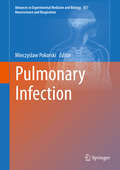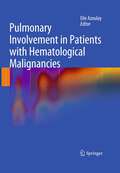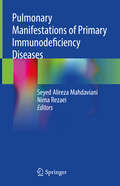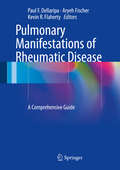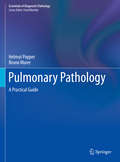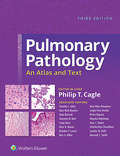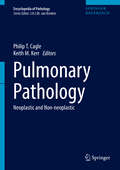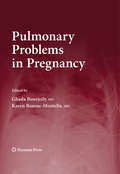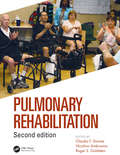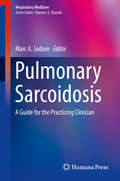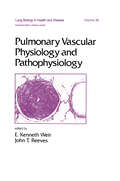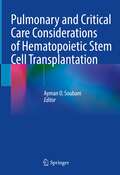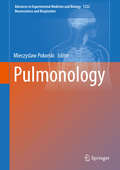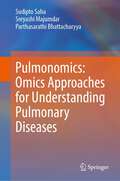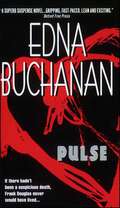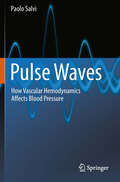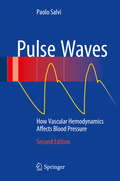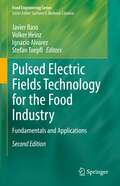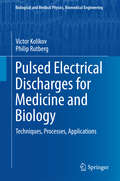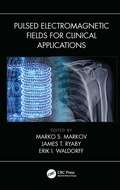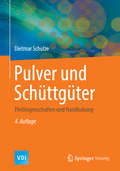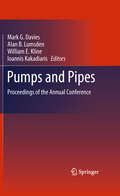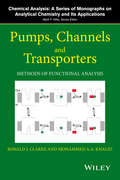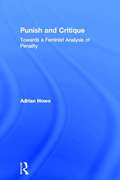- Table View
- List View
Pulmonary Infection
by Mieczyslaw PokorskiThe respiratory tract is a frequent target of infections caused by a wide range of organisms. The book provides reader-friendly information on aspects of pulmonary infections, including comprehensive accounts of bacterial and viral diseases, therapeutic approaches, molecular and classical culture-related techniques of diagnosis and explaining the basic cell biological mechanism. The role of oxidative stress, both helpful in fighting invading pathogens and detrimental in yielding to infection is detailed as it is often undervalued and needs focus. The chapters encompass latest developments and applications in bacteriology and virology, preventive and therapeutic tips, and raise attention to implementation of proper antibiotic policies by medical institutions to decrease resistance to antimicrobials. The perennial problem of low influenza vaccination coverage rate is rationalized. The volume will be of interest to both clinicians and biomedical researchers engaged in this exciting field.
Pulmonary Involvement in Patients with Hematological Malignancies
by Elie AzoulayThe number of patients treated for hematological malignancies is increasing steadily. To maximize cure rates, aggressive treatments have been introduced, including high-dose chemotherapy, stem cell transplantation, and targeted therapies. As a result, overall and disease-free survival rates have improved substantially, but at the price of life-threatening toxic and infectious complications that chiefly target the lung. This book provides clinicians caring for patients with hematological malignancies with detailed, up-to-date information on all relevant aspects of pulmonary involvement. Individual sections are devoted to epidemiology, diagnostic strategy, lung infections, non-infectious pulmonary involvement, and treatment, including decision making in patients with acute respiratory failure. Each of these sections contains a number of chapters, all written by leading international experts. In addition, the reader's attention is drawn to important "pearls" relating to each condition.
Pulmonary Manifestations of Primary Immunodeficiency Diseases
by Nima Rezaei Seyed Alireza MahdavianiThis book provides a broad overview of the respiratory manifestations associated with Primary Immune deficiencies (PID) congenital genetic defects such as infections, chronic inflammation, autoimmunity, lymphoproliferation, allergic manifestations and rare forms of cancer. Since the most common site of involvement in PID is the lung, the pulmonologists (pediatrics or adult), Internists and General Practitioners may be among the first to recognize the pattern of pulmonary disorders, leading to diagnosis of PID. Pulmonary complications present a significant cause of morbidity and also mortality among patients suffering from different forms of PID. With the prevalence of lung infections and disease so high in PID patients, respiratory professionals will find this book to be an essential resource for diagnosing, managing and referring PID related pulmonary disorders in clinical practice.
Pulmonary Manifestations of Rheumatic Disease
by Paul F. Dellaripa Aryeh Fischer Kevin R. FlahertyThe spectrum of systemic rheumatologic disease (often termed connective tissue disease) is characterized by autoimmune-mediated organ dysfunction, and the lungs are a frequent target. There are numerous pulmonary manifestations associated with connective tissue diseases, and all patients with rheumatologic disease are at risk of developing associated lung disease. Pulmonary Manifestations of Rheumatic Disease covers the comprehensive management of rheumatologic lung disease, which requires a multi-disciplinary approach and is optimized by active engagement by rheumatologists working closely with pulmonologists and other specialists. The book offers a practical reference using a case-based approach for practicing clinicians in the ongoing assessment and understanding of rheumatologic lung disease, and presents the science and pathophysiology underlying rheumatologic lung diseases. The first text of its kind specifically dedicated to describe diverse, commonplace, and challenging aspects of rheumatologic lung diseases, Pulmonary Manifestations of Rheumatic Disease serves as an invaluable tool for the practicing clinician.
Pulmonary Pathology: A Practical Guide (Essentials of Diagnostic Pathology)
by Helmut Popper Bruno MurerThis book provides an up-to-date overview of diagnostics in lung and pleura pathology. It helps surgical and clinical pathologist solve problem cases in lung and pleura tumor pathology as well as in other fields of pulmonary/pleura pathology such as interstitial lung disease, rare tumors, metabolic diseases, infectious pneumonias, pneumoconiosis, drug induced lung diseases, developmental and pediatric pulmonary pathology. Focusing on practical issues and providing numerous illustrated examples of typical and atypical cases, it guides residents as well as experienced pathologists through the problems and pitfalls in pulmonary and pleura pathology. References have been kept to a minimum.
Pulmonary Pathology: An Atlas and Text (Encyclopedia Of Pathology Ser.)
by Philip T. CagleEntirely re-written and revised with over 1,000 new images, Pulmonary Pathology: An Atlas and Text is a comprehensive, highly illustrated guide to diagnoses in pulmonary pathology, including tumors and lymphomas. The book—titled Color Atlas and Text of Pulmonary Pathology in earlier editions—combines highly detailed photographs and illustrations with concise, bulleted text so you can quickly grasp the information you need to make accurate diagnoses.
Pulmonary Pathology: Neoplastic And Non-neoplastic (Encyclopedia Of Pathology Ser.)
by Philip T. Cagle Keith M KerrThis book covers the complete field of pulmonary pathology - neoplastic and non-neoplastic - from Acinic cell tumor in the lung to Wegener`s Granulomatosis. The alphabetically arranged entries, each of which provides a detailed description of a specific pathological disease pattern, allow readers to quickly and easily find the information they need.
Pulmonary Problems in Pregnancy
by Karen Rosene-Montella Ghada BourjeilyClinically, pregnancy acts as a stress test that unmasks maternal disease and may have long-term implications for maternal and fetal health. In Pulmonary Problems in Pregnancy, the editors provide a state-of-the art, comprehensive text focusing on common or complex pulmonary issues occurring in pregnancy. For the first time, leading experts in the fields of obstetric, pulmonary, and critical care medicine provide novel and practical insights into improving the respiratory care of the pregnant patient. The book is divided into three sections. The first few chapters introduce the reader to the normal physiologic changes that occur during pregnancy. A chapter on high altitude is included to illustrate the consequences of chronic hypoxia on maternal and fetal outcomes, to help extrapolate to the effects of chronic pulmonary conditions. The second section reviews general management principles, including diagnostic imaging and prescribing in pregnancy. The final section includes multiple chapters on specific, troubling pulmonary disorders. The specific chapters are intended to summarize the available literature, linking science to bedside, and provide management recommendations whenever possible. In all, Pulmonary Problems in Pregnancy is an essential text that will not only provide critical clinical guidance but also stimulate further investigation into this fascinating and under explored area of medicine.
Pulmonary Rehabilitation (Current Topics In Rehabilitation Ser.)
by Claudio F. Donner, Nicolino Ambrosino and Roger S. GoldsteinPulmonary rehabilitation programmes are a fundamental part of the clinical management of patients with chronic respiratory diseases. This comprehensive reference book places pulmonary rehabilitation within the wider framework of respiratory disease. Now in six parts, it includes new sections on the development of PR as a discipline, global perspectives on quality control, new chapters on early PR post exacerbation and personalized rehabilitation, innovative approaches to exercise, PR in interstitial lung disease and lung transplantation, and the latest research into the application of music, dance and yoga. Key Features Global contributions compare practice around the world where differences have developed. New six Part structure covers new approaches to exercise testing, interstitial lung diseases and other diseases, and add-on interventions drawing on new technologies. Contains recommendations of the large collaborative ERS/ATS task forces on guidelines for PR as well as suggested policies for its implementation and use. Covers the important topic of balance impairment as a focus of rehabilitation for the at-risk patient and a new chapter on monitoring physical activity. The voices of patients and caregivers describe the impact of chronic respiratory disease on their lives. Features an exclusive chapter on COVID-19 that discusses the short- and long-term pathophysiological consequences, provides information about the potential role of physiotherapy in the management of hospitalized patients with confirmed or suspected COVID-19, and details on who, where, and how to deliver programs to COVID-19 and non COVID-19 patients in the lockdown and post lockdown era.
Pulmonary Sarcoidosis
by Marc A. JudsonPulmonary Sarcoidosis: A Guide for the Practicing Clinician is a valuable resource for clinicians of varied disciplines concerning the care of the sarcoidosis patient. Sarcoidosis is a multi-system disorder and represents a major challenge to physicians. Although any organ may be involved with sarcoidosis, the lung is the most common organ affected. Chapters are written by distinguished authors who have extensive experience in caring for these patients. Detailed figures and tables are provided to guide the practicing clinician through all aspects of the condition, from clinical manifestations to treatment options. Pulmonary Sarcoidosis: A Guide for the Practicing Clinician is fully comprehensive and evidence-based and will be an essential addition to the bookshelves of all whose practice involves the care and treatment of patients with sarcoidosis.
Pulmonary Tuberculosis and Its Prevention (Respiratory Disease Series: Diagnostic Tools and Disease Managements)
by Takefumi Saito Masahiro Narita Charles L. DaleyEvery year, 10 million people fall ill with tuberculosis (TB) in the world, and of those, 1.5 million people die even though it is a preventable and curable disease. As a result, TB remains the world’s leading infectious cause of death. On the other hand, in industrialized countries, the TB incidence has fallen to a historic low, and clinicians’ experience with TB diminished significantly in recent years. Additional challenges for clinicians include atypical presentation of TB in the immunocompromised, especially among the elderly, and an increasing number of patients with drug-resistant TB. Delayed diagnosis of TB leads to the spread of TB including nosocomial transmission because TB is an air-borne infectious disease, and suboptimal treatment can result in development of drug resistance. Furthermore, treatment of latent TB infection (LTBI) can prevent future TB cases but it has been under-utilized despite recent innovations in diagnosis and treatment regimens of LTBI. This book focuses on advances in diagnostic tools and treatment for both TB disease and latent TB infection. Each chapter/topic is written by one of the top TB experts in the field and the authors are from Japan and the US. Pulmonary Tuberculosis and its Prevention offers up-to-date information that can be incorporated into a busy practice of clinicians while they can appreciate broad international perspectives and gain in-depth knowledge on TB.
Pulmonary Vascular Physiology and Pathophysiology (Lung Biology in Health and Disease)
by E. Kenneth Weir John T. ReevesConsidering various aspects of pulmonary vascular control and the pulmonary vasculature's response to injury and disease, this monograph applies recent advances in molecular biology to increasing our understanding of cell proliferation, interactions between the endothelium and smooth muscle, and the etiologies of various forms of pulmonary hypertension.In addition, this book presents important reviews of lung phylogeny, right ventricular function, high altitude pulmonary edema, plus unique discussions of areas for which there have been no previous attempts to analyze all available information, such as pregnancy, diving, hyperbaria, and exercise.Pulmonary Vascular Physiology and Pathophysiology assesses the basic mechanisms underlying pulmonary health and disease ... investigates the response of pulmonary circulation to stress and disease ... highlights the ability of lung circulation to adapt to major environmental changes and varying metabolic demands ... and contains some 2,000 citations of relevant literature.Illustrated with nearly 170 diagrams, photomicrographs, and tables, Pulmonary Vascular Physiology and Pathophysiology is a superb reference for pulmonary physiologists, cardiologists, pediatricians, cardiovascular surgeons, anesthesiologists, pathologists, and cell and molecular biologists.
Pulmonary and Critical Care Considerations of Hematopoietic Stem Cell Transplantation
by Ayman O. SoubaniThis book serves as a guide to the pulmonary and critical care complications of hematopoietic stem cell transplantation (HSCT). HSCT is an important therapeutic modality for a variety of malignant and non-malignant conditions. The outcomes of these patients have been improving and the number of HSCT cases is increasing around the world. These patients, however, continue to have post-transplant complications related to conditioning regimens and graft vs. host disease. Pulmonary complications following HSCT remain a major cause of morbidity and mortality in this patient population.The book begins with an overview of HSCT and graft vs. host disease. Chapters then cover particular complications, including immunological changes in lungs, diffuse alveolar hemorrhage, bronchiolitis obliterans and pulmonary fibrosis. Other complications, including neurologic, renal, gastrointestinal, and cardiac, are covered. Chapters are comprehensive and consistent with each defining the scope of the complication, epidemiology, risk factors, diagnostic approach, management, outcome and predictors of outcome, and future directions. The book provides insight as well on matters that arise during the care of HSCT patients such as provider burnout, nursing care, intensive care unit organization, nutritional support, and pulmonary and physical rehabilitation. This is an ideal guide for pulmonologists, critical care physicians, transplant specialists, oncologists, and relevant trainees caring for patients who have undergone HSCT.
Pulmonology (Advances in Experimental Medicine and Biology #1222)
by Mieczyslaw PokorskiThis book addresses several burning issues concerning diseases involving the lungs and respiratory tract.It discusses the epidemiology, mechanisms, prevention, and diagnosis of chest conditions such as chronic obstructive pulmonary disease, sleep apnea and respiratory infections. Further, it examines the intertwined connection between oxidative stress, cardiovascular disorders such as hypertension, and the occurrence and course of obstructive sleep apnea. It also provides pulmonologists with valuable information on the diagnosis and treatment of patients with severe airway obstruction or respiratory tract infections. Other topics covered include viral infections of the airways, such as influenza, particularly in high-risk groups like pediatric populations, as well as psychosocial aspects, e.g., quality of life in lung cancer patients. Combining basic science and clinical practice, the articles provide key insights and highlight the areas of still limited understanding of disease processes. Stimulating new directions in clinical practice, this collection of articles is intended for respiratory physicians, clinical experts, family practitioners, and all allied healthcare professionals.
Pulmonomics: Omics Approaches for Understanding Pulmonary Diseases
by Sudipto Saha Sreyashi Majumdar Parthasarathi BhattacharyyaThis book comprehensively reviews various omics approaches like genomics, proteomics, transcriptomics, and metabolomics for understanding pulmonary disease at molecular and systems levels. The initial chapters present the pathogenesis of major pulmonary diseases, namely, obstructive diseases, restrictive diseases, vascular diseases, infectious diseases, and neoplastic carcinoma. The book chapters provide current information about the role of the microbiome and applications of medical imaging, bioinformatics tools, and databases for diagnosis and designing treatment strategies against complex lung diseases. Further, the book discusses omics technologies to identify biomarkers for the early diagnosis and prognosis of pulmonary diseases. Finally, the book elucidates the multi-omics approaches and data integration using mathematical modeling for insights into the disease etiology towards improving the prognostics and predictive accuracy of disease phenotypes.
Pulse
by Edna BuchananA transplant patient unravels the mysterious death of his heart donor in this “greased-lightning thriller from the Pulitzer-winning crime reporter” (Kirkus). If Daniel Alexander had not committed suicide, Frank Douglas would never have lived to see his forty-fifth birthday. Alexander’s heart now beats strong and sure in Douglas’s chest. The donated organ has given the successful Miami businessman a second chance . . . but it gives him no peace.Disturbed by nagging feelings of guilt, Frank sets out to discover all he can about his benefactor. His search leads him to Rory Alexander—Daniel’s beautiful, enigmatic wife—and to troubling questions about the late man’s affairs. Why, for example, have the profits from Alexander’s business ventures mysteriously vanished? And why is Rory so unshakably certain that her husband was murdered? Pursuing the answers leads Frank into a twisted tale of greed, secrets, and savagery—one that puts his newly grated life in serious peril.
Pulse Waves
by Paolo SalviRecently, several studies have shown the crucial role of viscoelastic properties of the aorta and large arteries in determining blood pressure values. A good knowledge of cardiovascular pathophysiology and vascular hemodynamics is necessary to understand these phenomena. However, available texts on this topic are very complex and difficult for medical practitioners to understand. The aim of this book is to enable the reader to comprehend the relation between cardiovascular pathophysiology and vascular hemodynamics and to become familiar with the more recent guidelines. While very complex physical concepts are involved, care has been taken to ensure that the explanations are as straightforward as possible. Complex analyses are presented separately and can be skipped by the reader without impairment of understanding. It is envisaged that the knowledge imparted will prove invaluable in improving the approach to hypertensive patients.
Pulse Waves
by Paolo SalviThis new, revised and updated edition takes into account the most recent advances in the understanding of human pathophysiology. The book presents the complex basic principles of vascular hemodynamics and its pathophysiologie in a direct and effective way, stressing the importance of the mechanical properties of large arteries in the origin of blood pressure. The readily understandable text, supported by helpful images, describes the elements that define blood pressure and explains such important concepts as pulse wave velocity, central blood pressure, reflected waves, and pulse pressure amplification. Entirely new chapters are included on the sympathetic nervous system and arterial stiffness and on the role played by arterial stiffness in influencing blood pressure variability. The book will enable the physician to answer some of the key questions encountered when addressing the problem of arterial hypertension in everyday clinical practice: How is blood pressure generated? How should blood pressure values be interpreted? Is systolic blood pressure of greater importance than diastolic blood pressure?
Pulsed Electric Fields Technology for the Food Industry: Fundamentals and Applications (Food Engineering Series)
by Volker Heinz Javier Raso Ignacio Alvarez Stefan ToepflMany novel technologies have been proposed in the attempt to improve existing food processing methods. Among emerging nonthermal technologies, high intensity pulsed electric fields (PEF) is appealing due to its short treatment times and reduced heating effects. This book presents information accumulated on PEF during the last 15 years by experienced microbiologists, biochemists, food technologists, and electrical and food engineers.
Pulsed Electrical Discharges for Medicine and Biology
by Victor Kolikov Philip RutbergThis book presents the application of pulsed electrical discharges in water and water dispersions of metal nanoparticles in medicine (surgery, dentistry, and oncology), biology and ecology. The intensive electrical and shock waves represent a novel technique to destroy viruses and this way to prepare anti-virus vaccines. The method of pulsed electrical discharges in water allows to decontaminate water from almost all known bacteria and spores of fungi being present in human beings. The nanoparticles used are not genotoxic and mutagenic. This book is useful for researchers and graduate students.
Pulsed Electromagnetic Fields for Clinical Applications
by Marko S. Markov James T. Ryaby Erik I. WaldorffPulsed Electromagnetic Fields for Clinical Applications presents the historical development, the state of art, and the future of the application of pulsed electromagnetic fields (PEMFs) for the treatment of various medical problems, including initiating various healing processes from delayed fractures and pain relief to multiple sclerosis and Parkinson’s disease. The emphasis is on the development of scientific methods to be implemented in clinical application. In perspective, this modality provides a practical, exogenous method for inducing cell and tissue modification attempted to the injured tissues to their normal physiological status. The book reviews the current state of equipment for PEMFs and highlights worldwide therapeutic achievements. It explores the past, present, and future of PEMF therapies. It presents the development of theory and laboratory research during the last 70 years. It reviews the available equipment for PEMF. It reviews the state of the art of worldwide therapeutic achievements. It includes recent achievements and applications of electroporation modalities.
Pulver und Schüttgüter: Fließeigenschaften und Handhabung (VDI-Buch)
by Dietmar SchulzeErfahren Sie in diesem Buch alles über die Eigenschaften von Pulvern und Schüttgütern sowie deren Anwendung in der PraxisDas theoretische Wissen um das Verhalten von Pulvern und Schüttgütern ist im Ingenieurwesen mittlerweile weit verbreitet. Beim Blick in die Praxis – speziell bei der Schüttgutlagerung in Silos – fehlt es jedoch nach wie vor an Vertrauen in diese Methode. Das möchte Dietmar Schulze mit diesem Buch über Pulver und Schüttgüter ein für alle Mal ändern. In seinem Buch erläutert er daher die Fließeigenschaften und -fähigkeiten dieser Komponenten und zeigt, wie dieses Wissen in die Gestaltung von Anlagenteilen wie Trichtern oder Silos praktisch angewendet werden kann. Anhand von Berechnungsaufgaben mit Lösungen können Sie Ihren aktuellen Wissensstand prüfen und erweitern.Von der Theorie zur Gestaltung von SchüttgutbehälternSchulze hat sein Buch über Pulver und Schüttgüter in zwei Bereiche aufgeteilt. In drei Kapiteln erörtert er die theoretischen Grundlagen zum Umgang mit Schüttgütern im Ingenieurwesen. Hier lernen Sie alles über: • Wechselwirkungen zwischen Partikeln• Fließeigenschaften und deren Messung• Einflüsse auf das Fließverhalten (z.B. Feuchtigkeit, Zeit, Fließhilfsmittelgehalt)Nach diesem theoretischen Grundlagen-Exkurs wendet sich der Autor der Schüttguttechnik in der Praxis zu. Schulze erläutert, wie Sie die gemessenen Fließeigenschaften zur funktionsgerechten Gestaltung von Schüttgutbehältern wie Silos und Trichtern anwenden können. Zudem bekommen Sie einen Einblick in apparative Aspekte sowie das praktische Messen von Fließeigenschaften – insbesondere mit Hilfe von Schergeräten.Die vierte, ergänzte Auflage – ideal für NeueinsteigerAbschließend befasst sich dieses Buch mit der verfahrenstechnischen Siloauslegung. Hier widmet sich der Autor Aspekten wie der Silogestaltung, dem Schüttgutaustrag, der Entmischung sowie dem Phänomen von Erschütterungen und Schwingungen in Silos. Für die vierte Auflage wurden in mehreren Kapiteln Ergänzungen vorgenommen, u.a. bei der Entmischung zur Probenahme und zur Bewertung der Mischungsqualität mittels statistischer Methoden, und bei der Siloauslegung mit weiteren Berechnungsdiagrammen.
Pumps and Pipes
by Alan B. Lumsden Ioannis Kakadiaris Mark G. Davies William E. KlineThe Pumps and Pipes collaboration and conference brings together energy, medicine, and higher education in a unique shared effort, exploring ideas and research common to these important fields and stimulating discussion and sharing technologies that can further the reach and goals of each individual area. The Proceedings explores the common attributes of oil and gas technology, computational sciences and cardiovascular medicine and probe the areas where there is room to cross-fertilize and develop research and commercial programs.
Pumps, Channels and Transporters
by Ronald J. Clarke Mohammed A. KhalidDescribes experimental methods for investigating the function of pumps, channels and transporters Covers new emerging analytical methods used to study ion transport membrane proteins such as single-molecule spectroscopy Details a wide range of electrophysiological techniques and spectroscopic methods used to analyze the function of ion channels, ion pumps and transporters Covers state-of-the art analytical methods to study ion pumps, channels, and transporters, and where analytical chemistry can make further contributions
Punish and Critique: Towards a Feminist Analysis of Penality (Sociology of Law and Crime)
by Adrian HoweAcknowledgements Introduction 1. Political economies of punishment 2. 'New histories of punishment regimes 3. The Foucault Effect: from penology to penality 4. Feminist analytical approaches to women's imprisonment 5. Postmodern feminism and the question of penalty 6. Towards a postmodern penal politic? Bibliography
